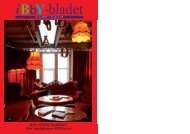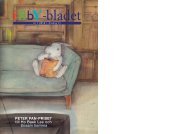Anna-Clara Tidholm
Anna-Clara Tidholm
Anna-Clara Tidholm
Create successful ePaper yourself
Turn your PDF publications into a flip-book with our unique Google optimized e-Paper software.
Then already by the beginning<br />
of the 1980’s did they develop their<br />
joint view of the picture book as<br />
story telling without the need of<br />
traditional (adult) dramaturgy,<br />
since children have not acquired<br />
the same literary expectations as<br />
adults, they “assemble” a plot on<br />
significantly looser grounds, as in<br />
this case, scene after scene linked<br />
together into a rather loose, open<br />
and impressionist construction.<br />
In 1987 their book “Resan till<br />
Ugri-la-Brek” was published (“The<br />
Journey to Ugri-la-Brek”, awarded<br />
with the Deutscher Jugendliteraturpreis<br />
1992). Here two children are<br />
looking for their grandfather.<br />
<strong>Anna</strong>-<strong>Clara</strong> <strong>Tidholm</strong> shows how<br />
they, a bit afraid and lost, look into<br />
his apartment, the door ajar behind<br />
them and the dog in front of<br />
them in the room, the apartment<br />
is empty, his eye glasses still there<br />
thus leaving him without the ability<br />
to fill in the form for the foot-<br />
6<br />
ball pools. Then after the children<br />
after many adventures and a long<br />
journey to “the Other side of the<br />
World” find him to hand him his<br />
eyeglasses, she chooses the same<br />
composition, the same scenography,<br />
to demonstrate how limited<br />
and dependent on reality the imagination<br />
of children is.<br />
In the parallel image, the children<br />
display the same hesitation as<br />
in the first picture, the open door<br />
behind them and the dog in front of<br />
them, in the same yet slightly different<br />
room. Their grandfather is sitting<br />
in his chair and reassures them<br />
that he is fine and that he does not<br />
need his eyeglasses any more.<br />
They cannot imagine his new existence<br />
differently: that grandfather<br />
perhaps (probably) is dead is never<br />
mentioned or shown. This fact has<br />
to be concluded by every child who<br />
is prepared to do so. The pictures<br />
(as well as text) express their only<br />
possible perspective, the child’s perspective,<br />
and they are in this sense<br />
profoundly “childological”.




